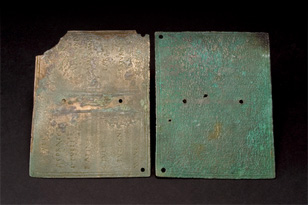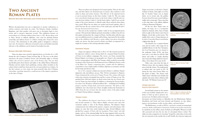The Romans used two different metal-writing techniques in making these plates. Sides A and D were cast before sides B and C were inscribed. The letters on the outer faces (A and D) of the plates were cast through the lost wax mold-and-casting process. Then the words on the interior faces of the plates were inscribed with a hammer and chisel, after which the plates were sealed and bound together to prevent tampering.
The two plates are each 4.8 inches (12.2 cm) by 6.4 inches (16.2 cm). Each plate is 1 to 1.1 millimeter thick, about the thickness of thin cardboard, and weighs about 2.5 ounces (70 grams). A replica set of plates is also on display for visitors to handle. The replicas in the exhibition were created in a studio in Salt Lake County, using a single mold-and-casting process. Although accurate in dimension and detail, the replica plates weigh about 11.5 ounces each (325 grams)—four and a half times as much as the ancient bronze plates.
Download a High Definition version of this video
(To view videos you must have Quicktime 7 installed)






